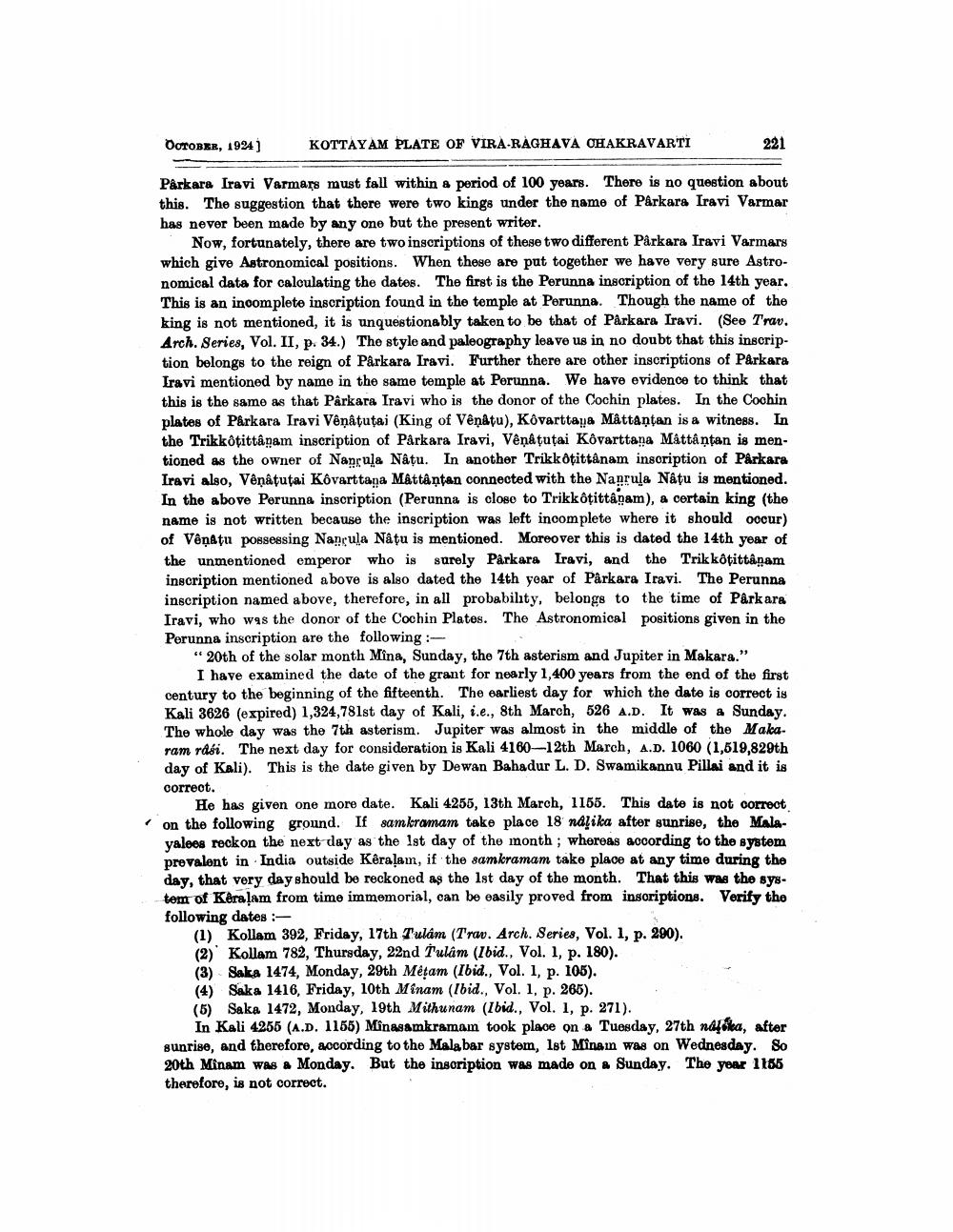________________
OCTOBER, 1924)
KOTTAYAM PLATE OF VIRA-RAGHAVA CHAKRAVARTI
221
Pårkara Iravi Varmars must fall within a period of 100 years. There is no question about this. The suggestion that there were two kings under the name of Parkara Iravi Varmar has never been made by any one but the present writer.
Now, fortunately, there are two inscriptions of these two different Parkara Iravi Varmars which give Astronomical positions. When these are put together we have very sure Astronomical data for caloulating the dates. The first is the Perunna inscription of the 14th year. This is an incomplete inscription found in the temple at Perunna. Though the name of the king is not mentioned, it is unquestionably taken to be that of Parkara Iravi. (See Trav. Arch. Series, Vol. II, p. 34.) The style and paleography leave us in no doubt that this inscription belongs to the reign of Parkara Iravi. Further there are other inscriptions of Parkara Iravi mentioned by name in the same temple at Perunna. We have evidence to think that this is the same as that Parkara Iravi who is the donor of the Cochin plates. In the Cochin plates of Pårkara Iravi Vênâțutai (King of Vêņâțu), Kóvarttana Måttantan is a witness. In the Trikkotittayam inscription of Pårkara Iravi, Vêņâțutai Kóvarttana Mattântan is mentioned as the owner of Naprula Nâțu. In another Trikkôţittânam inscription of Pårkara Iravi also, Vêņâtutai Kóvarttapa Mâttântan connected with the Naprula Nâțu is mentioned. In the above Perunna inscription (Perunna is close to Trikkôțittapam), a certain king (the name is not written because the inscription was left incomplete where it should oocur) of Vêņatu possessing Nancula Natu is mentioned. Moreover this is dated the 14th year of the unmentioned emperor who is surely Parkara Iravi, and the Trik koţittânam inscription mentioned above is also dated the 14th year of Pârkara Iravi. The Perunna inscription named above, therefore, in all probability, belongs to the time of Park ara Iravi, who was the donor of the Cochin Plates. The Astronomical positions given in the Perunna inscription are the following :
“20th of the solar month Mina, Sunday, the 7th asterism and Jupiter in Makara."
I have examined the date of the grant for nearly 1,400 years from the end of the first century to the beginning of the fifteenth. The earliest day for which the date is correct is Kali 3626 (expired) 1,324,781st day of Kali, i.e., 8th March, 526 A.D. It was a Sunday. The whole day was the 7th asterism. Jupiter was almost in the middle of the Maka. ram rdši. The next day for consideration is Kali 4160—12th March, A.D. 1060 (1.519.829th day of Kali). This is the date given by Dewan Bahadur L. D. Swamikannu Pillai and it is correct.
He has given one more date. Kali 4255, 13th March, 1155. This date is not correct on the following ground. If sam kramam take place 18 naţika after sunrise, the Malayalees reckon the next day as the 1st day of the month ; whereas according to the system prevalent in India outside Kéralam, if the samkramam take place at any time during the day, that very day should be reckoned as the 1st day of the month. That this was the system of Keralam from time immemorial, can be easily proved from inscriptions. Verify the following dates -
(1) Kollam 392, Friday, 17th Tulam (Trav. Arch. Series, Vol. 1, p. 290). (2) Kollam 782, Thursday, 22nd l'ulam (Ibid., Vol. 1, p. 180). (3) Saka 1474, Monday, 29th Métam (Ibid., Vol. 1, p. 106). (4) Saka 1416, Friday, 10th Minam (Ibid., Vol. 1, p. 265). (5) Saka 1472, Monday, 19th Mithunam (Ibid., Vol. 1, p. 271).
In Kali 4255 (A.D. 1166) Minasamkramam took place on a Tuesday, 27th natoka, after sunrise, and therefore, according to the Malabar system, lst Minam was on Wednesday. So 20th Minam was a Monday. But the inscription was made on a Sunday. The year 1155 therefore, is not correct.




